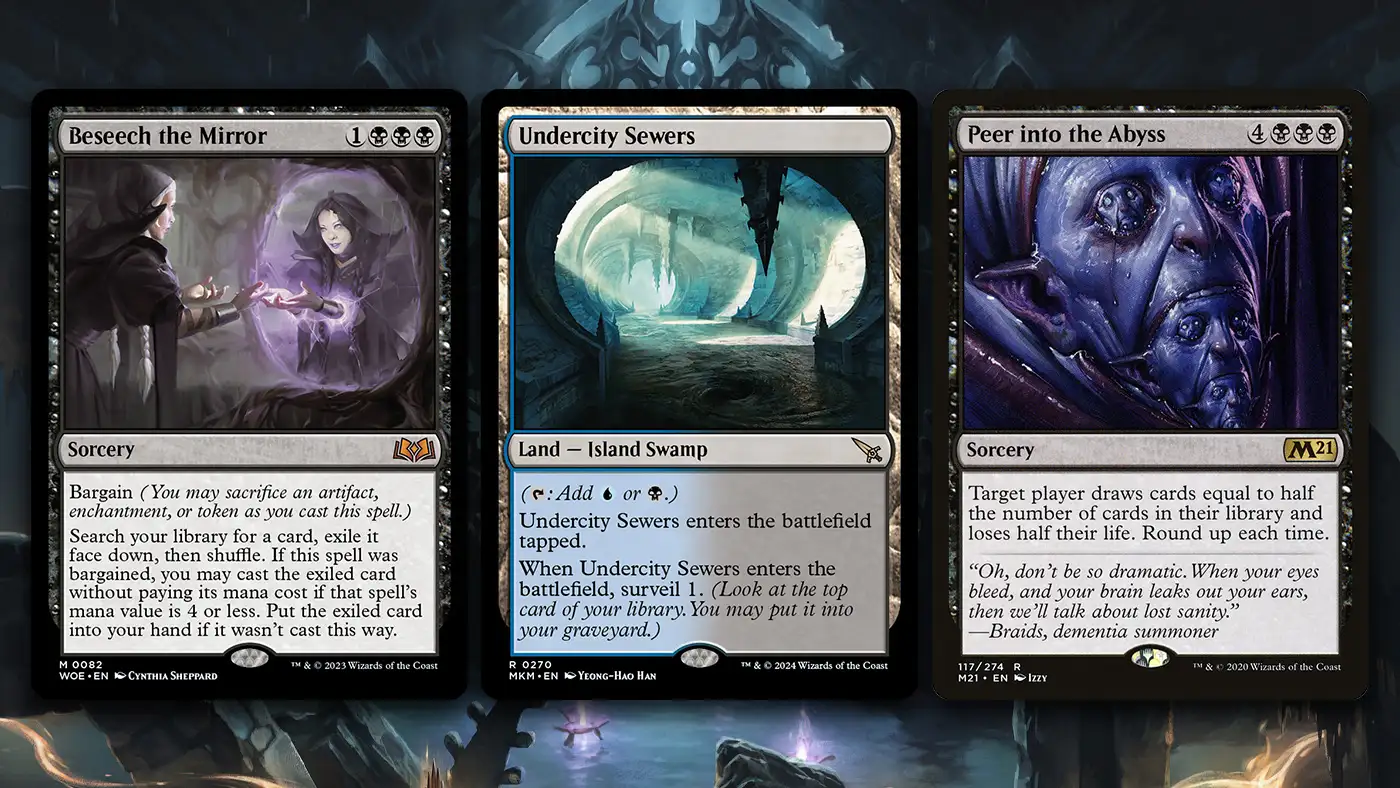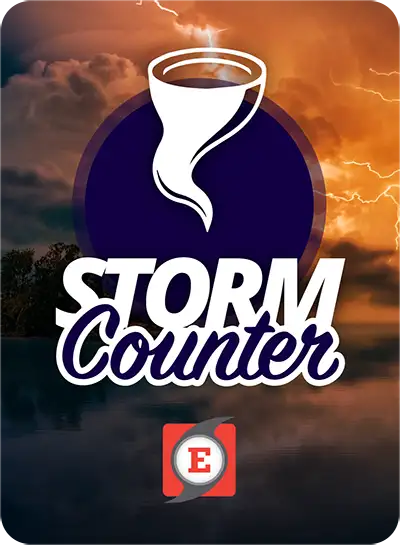The loss of potential gain from other alternatives when one alternative is chosen.-Oxford Dictionary
Opportunity cost is a term normally associated with finance and investing. In
Magic: The Gathering, opportunity cost has deck building and playing applications. While playing, it tends to be more tactical. It is a decision to play a given card with the resources on one turn versus playing another with those same resources. Deck building is where understanding this concept and a related
"results-based analysis" can lead to a better deck.
The Cost of a Slot
[[Peer into the Abyss|]]
[[Lightning Bolt|]]
[[Stony Silence|]]
Every card you choose to put into your deck has another choice. There are many more cards you choose not to play by selecting the set of cards for your deck. During deck building, you often look to maximize some aspect of the deck. For brevity's sake, I will stick to competitive formats where winning is the goal of every deck (i.e., having the set of cards that wins most often).While it is not reasonable to actually calculate the win rate of card A in a slot against card B, it can be a useful thought exercise to illustrate the power of opportunity cost. If a card existed that won the game 1/100 times it was drawn and did nothing the remaining 99 times, that would likely not be a good card. Often, that card would be a dead draw, and the utility of the card is low.However,
Magic: The Gathering is a random game; the first couple of times you draw the card, it could hit that 1/100 odds and win on the spot. Relying on only those first few times the card was drawn without further thought is a results-based analysis. In this hypothetical, since we know the actual utility of the card and that the first few draws are outliers, we can safely cut the card.If you have ever felt that feeling of,
"If only I hadn't cut my only card that beats my opponent here," you have felt what opportunity cost does. By choosing to have something, a card that could have won the game in question was cut. This feeling motivates players to add those cards again because decisions that lead to a real loss feel bad.Going back and making those changes would result from results-based analysis, which is malpractice. When the cards you chose to include in your deck win games, it leaves less of an impression because that's what those cards are expected to do. Games going normally are normal.Drawing dead cards is easier to discard because it often happens in
Magic: The Gathering with lands. The game system has trained you to accept some dead draws some amount of the time and assign it to random variance — something out of your control. Sometimes, that is true. Other times, it could have been solved with good deck building. Balancing those facets is what the opportunity cost is all about.Careful testing and awareness of when cards are especially good matters. When building recent versions of The EPIC Storm (TES), we realized that the cost of playing [[Peer into the Abyss]] was too high compared to a sideboard [[Beseech the Mirror]]. This one change has several knock-on effects to the deck and how it can win.[[Burning Wish]] became a better card. It could win deterministically with lower resources than [[Peer into the Abyss]]. [[Lion's Eye Diamond]] got better in concert with [[Burning Wish]] for the same reason. We believe this wins more games than the previous set of cards. However, these changes are not free.TES does not just win all of the games it won before and more because of this change. The cost of having a sideboard [[Beseech the Mirror]] is that it is harder to naturally draw it. In play testing, we felt this. We cast many cantrips and could not find a card that won the game. While this was bad variance, it did not feel good in the moment. We had to remind ourselves that having the sideboard [[Beseech the Mirror]] wins more games and did not need [[Peer into the Abyss]].However, if we had realized that the opportunity cost of the sideboard [[Beseech the Mirror]] was too high, we would have moved back. This would have looked like the sideboard [[Beseech the Mirror]] not winning the number of games we expected or running into many spots where the only card that won was [[Peer into the Abyss]]. Sometimes, that voice saying,
"If only you had not cut that card," is right, and you change your deck back.There are slots where playing a low-utility/high-impact card is good. Those are most often sideboard slots. [[Stony Silence]] is excellent against
Affinity, while it would do little against Azorius Control. By being able to choose which games the card can be drawn by sideboarding it in, it decreases the number of times it is a dead draw.
A Cedh Example
[[Rograkh, Son of Rohgahh|]]
[[Jeweled Lotus|]]
[[Kraum, Ludevic's Opus|]]
In the Commander channel of the
Storm Discord, a user asked about playing a Grixis deck, [[Rograkh, Son of Rohgahh]]/[[Silas Renn, Seeker Adept]] vs a sans-green deck, [[Tymna the Weaver]]/[[Kraum, Ludevic's Opus]]. While both decks have similar strategies of using [[Ad Nauseam]], [[Underworld Breach]], and [[Thassa's Oracle]], [[Tymna the Weaver]]/[[Kraum, Ludevic's Opus]] is seen as a slower deck with more ability to rebuild after bad mulligans or when its combo is countered.While there was more to the discussion, it became centered around the card [[Jeweled Lotus]]. [[Rograkh, Son of Rohgahh]]/[[Silas Renn, Seeker Adept]] does not play the card because it does not intend to spend mana to cast its commanders. While [[Black Lotus]] variants are quite powerful, I doubt [[Jeweled Lotus]] is worth the slot in decks where the commanders provide a small amount of card advantage.[[Wheel of Fortune]] effects run rampant in the format. [[Mystic Remora]] can draw upwards of 10 cards on some turn cycles. Drawing cards is not a problem in cEDH. My argument was that [[Tymna the Weaver]] and [[Kraum, Ludevic's Opus]] are likely the least powerful cards in the entire Vintage power level deck. Playing a card that solely enables these cards is not worth the slot. By playing [[Jeweled Lotus]], the deck gives up consistency in executing its winning game plan of one of those combo engines or another tutor effect for one of the best draw engines in the format.[[Jeweled Lotus]] is an exemplary case study for opportunity cost because it feels like a card that should be powerful. It feels good to cast when it is good and is not always dead. There is a false agency that players feel in their mulligans. Cedh is a format that abuses the London Mulligan for bailouts. Still, players often keep hands that produce mediocre draw engines instead of mulliganing. This potentially misses a lot of emotional pressure.If we look at the mechanics of what [[Jeweled Lotus]] does in a game, it is much less impressive. [[Jeweled Lotus]] spends a card to accelerate out a card that draws more cards. It changes the dynamic of commanders from being the eighth and ninth cards to just seventh and eighth. Going down a card to draw more cards is sometimes right if the latter provides enough advantage. My argument is that [[Tymna the Weaver]] and [[Kraum, Ludevic's Opus]] do not draw enough cards fast enough. As such, another card, like an additional [[Wheel of Fortune]] effect or the next best tutor effect, should be considered instead.Measuring the results of a change like cutting [[Jeweled Lotus]] is really challenging. So many decisions factor into how games play out that it's impossible to tell until you play without the card. Real-life applications are hard!
The Surveil lands
[[Thundering Falls|]]
[[Undercity Sewers|]]
[[Commercial District|]]
Playing a
Surveil land or two is quite common in formats with fetch lands. TES was an early adopter of
Surveil lands because Bryant felt they were too free not to play. To put this in opportunity cost terms, he felt that the benefits of fetching for a
Surveil land when there was nothing else to do outweighed the drawbacks of occasionally drawing a tapped mana source.I was doubtful that this cleared the bar in a format with [[Wasteland]] and how fast TES is. However, I was willing to play
Surveil lands and be wrong. It turned out that they were quite powerful. The drawback did not matter nearly as much as I presumed. The
Surveil has been worthwhile by changing a few play patterns. Most decks in Legacy and Modern came to the same conclusion, but I did not expect a land cycle that would replace the original dual lands.Once we decided to play two
Surveil lands, TES got other knock-on effects. There is an engine that TES has played main deck before that likes putting cards into the Graveyard: [[Echo of Eons]]. There are several tricks with [[Brainstorm]] and [[Ponder]] with the
Surveil lands, but adding three copies of [[Echo of Eons]] to the main deck also solved a problem that came about from moving the fourth [[Beseech the Mirror]] to the sideboard: it added so much more action to the deck. By making one change that caused a weakness, we could cover it by changing other slots. This brought the deck to an extremely strong
"Equilibrium State" and Bryant was able to
Top 8 SCG Philadelphia!Thank you for taking the opportunity to spend your time reading this article instead of reading something else on the internet!
Murder at Karlov Manner's
Surveil lands was the clearest example of opportunity cost we have had in deck building in a long time. If you want the opportunity to talk to me or the rest of The EPIC Storm team, reach out on
Twitter,
Storm Discord or the comments of wherever you found this article! If you want early access to this article, check out The EPIC Storm
Patreon and support us there.










